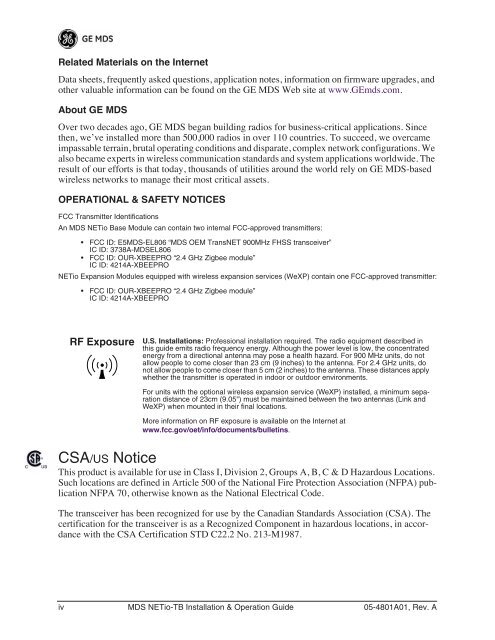MDS NETio-TBTM Series - GE Digital Energy
MDS NETio-TBTM Series - GE Digital Energy
MDS NETio-TBTM Series - GE Digital Energy
Create successful ePaper yourself
Turn your PDF publications into a flip-book with our unique Google optimized e-Paper software.
Related Materials on the InternetData sheets, frequently asked questions, application notes, information on firmware upgrades, andother valuable information can be found on the <strong>GE</strong> <strong>MDS</strong> Web site at www.<strong>GE</strong>mds.com.About <strong>GE</strong> <strong>MDS</strong>Over two decades ago, <strong>GE</strong> <strong>MDS</strong> began building radios for business-critical applications. Sincethen, we’ve installed more than 500,000 radios in over 110 countries. To succeed, we overcameimpassable terrain, brutal operating conditions and disparate, complex network configurations. Wealso became experts in wireless communication standards and system applications worldwide. Theresult of our efforts is that today, thousands of utilities around the world rely on <strong>GE</strong> <strong>MDS</strong>-basedwireless networks to manage their most critical assets.OPERATIONAL & SAFETY NOTICESFCC Transmitter IdentificationsAn <strong>MDS</strong> <strong>NETio</strong> Base Module can contain two internal FCC-approved transmitters:• FCC ID: E5<strong>MDS</strong>-EL806 “<strong>MDS</strong> OEM TransNET 900MHz FHSS transceiver”IC ID: 3738A-<strong>MDS</strong>EL806• FCC ID: OUR-XBEEPRO “2.4 GHz Zigbee module”IC ID: 4214A-XBEEPRO<strong>NETio</strong> Expansion Modules equipped with wireless expansion services (WeXP) contain one FCC-approved transmitter:• FCC ID: OUR-XBEEPRO “2.4 GHz Zigbee module”IC ID: 4214A-XBEEPRORF ExposureU.S. Installations: Professional installation required. The radio equipment described inthis guide emits radio frequency energy. Although the power level is low, the concentratedenergy from a directional antenna may pose a health hazard. For 900 MHz units, do notallow people to come closer than 23 cm (9 inches) to the antenna. For 2.4 GHz units, donot allow people to come closer than 5 cm (2 inches) to the antenna. These distances applywhether the transmitter is operated in indoor or outdoor environments.For units with the optional wireless expansion service (WeXP) installed, a minimum separationdistance of 23cm (9.05") must be maintained between the two antennas (Link andWeXP) when mounted in their final locations.More information on RF exposure is available on the Internet atwww.fcc.gov/oet/info/documents/bulletins.CSA/US NoticeThis product is available for use in Class I, Division 2, Groups A, B, C & D Hazardous Locations.Such locations are defined in Article 500 of the National Fire Protection Association (NFPA) publicationNFPA 70, otherwise known as the National Electrical Code.The transceiver has been recognized for use by the Canadian Standards Association (CSA). Thecertification for the transceiver is as a Recognized Component in hazardous locations, in accordancewith the CSA Certification STD C22.2 No. 213-M1987.iv <strong>MDS</strong> <strong>NETio</strong>-TB Installation & Operation Guide 05-4801A01, Rev. A

















